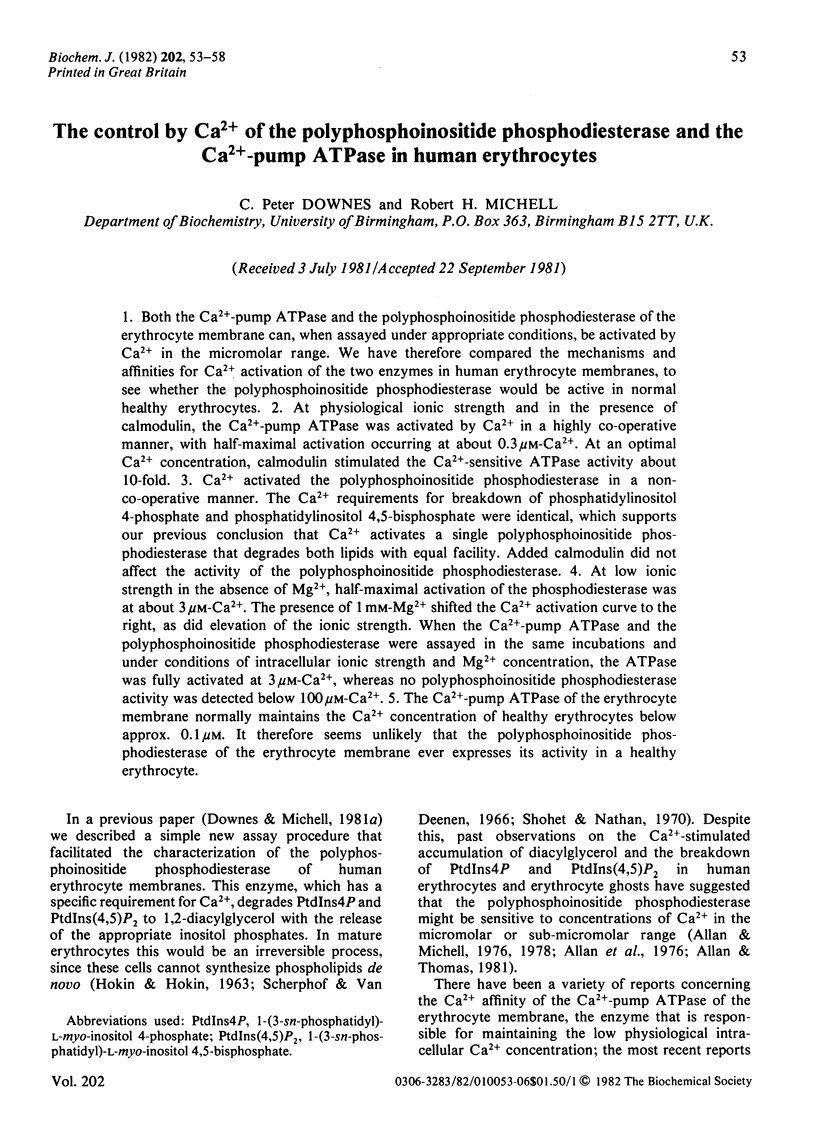The control by Ca2+ of the polyphosphoinositide phosphodiesterase and the Ca2+-pump ATPase in human erythrocytes (original) (raw)
Abstract
1. Both the Ca2+-pump ATPase and the polyphosphoinositide phosphodiesterase of the erythrocyte membrane can, when assayed under appropriate conditions, be activated by Ca2+ in the micromolar range. We have therefore compared the mechanisms and affinities for Ca2+ activation of the two enzymes in human erythrocyte membranes, to see whether the polyphosphoinositide phosphodiesterase would be active in normal healthy erythrocytes. 2. At physiological ionic strength and in the presence of calmodulin, the Ca2+-pump ATPase was activated by Ca2+ in a highly co-operative manner, with half-maximal activation occurring at about 0.3μm-Ca2+. At an optimal Ca2+ concentration, calmodulin stimulated the Ca2+-sensitive ATPase activity about 10-fold. 3. Ca2+ activated the polyphosphoinositide phosphodiesterase in a non-co-operative manner. The Ca2+ requirements for breakdown of phosphatidylinositol 4-phosphate and phosphatidylinositol 4,5-bisphosphate were identical, which supports our previous conclusion that Ca2+ activates a single polyphosphoinositide phosphodiesterase that degrades both lipids with equal facility. Added calmodulin did not affect the activity of the polyphosphoinositide phosphodiesterase. 4. At low ionic strength in the absence of Mg2+, half-maximal activation of the phosphodiesterase was at about 3μm-Ca2+. The presence of 1mm-Mg2+ shifted the Ca2+ activation curve to the right, as did elevation of the ionic strength. When the Ca2+-pump ATPase and the polyphosphoinositide phosphodiesterase were assayed in the same incubations and under conditions of intracellular ionic strength and Mg2+ concentration, the ATPase was fully activated at 3μm-Ca2+, whereas no polyphosphoinositide phosphodiesterase activity was detected below 100μm-Ca2+. 5. The Ca2+-pump ATPase of the erythrocyte membrane normally maintains the Ca2+ concentration of healthy erythrocytes below approx. 0.1μm. It therefore seems unlikely that the polyphosphoinositide phosphodiesterase of the erythrocyte membrane ever expresses its activity in a healthy erythrocyte.

Selected References
These references are in PubMed. This may not be the complete list of references from this article.
- Allan D., Michell R. H. A calcium-activated polyphosphoinositide phosphodiesterase in the plasma membrane of human and rabbit erythrocytes. Biochim Biophys Acta. 1978 Apr 4;508(2):277–286. doi: 10.1016/0005-2736(78)90330-9. [DOI] [PubMed] [Google Scholar]
- Allan D., Michell R. H. Calcium ion-dependent diacylglycerol accumulation in erythrocytes is associated with microvesiculation but not with efflux of potassium ions. Biochem J. 1977 Sep 15;166(3):495–499. doi: 10.1042/bj1660495. [DOI] [PMC free article] [PubMed] [Google Scholar]
- Allan D., Michell R. H. Phosphatidylinositol cleavage in lymphocytes. Requirement for calcium ions at a low concentration and effects of other cations. Biochem J. 1974 Sep;142(3):599–604. doi: 10.1042/bj1420599. [DOI] [PMC free article] [PubMed] [Google Scholar]
- Allan D., Michell R. H. Production of 1,2-diacylglycerol in human erythrocyte membranes exposed to low concentrations of calcium ions. Biochim Biophys Acta. 1976 Dec 14;455(3):824–830. doi: 10.1016/0005-2736(76)90052-3. [DOI] [PubMed] [Google Scholar]
- Allan D., Thomas P. The effects of Ca2+ and Sr2+ on Ca2+-sensitive biochemical changes in human erythrocytes and their membranes. Biochem J. 1981 Sep 15;198(3):441–445. doi: 10.1042/bj1980441. [DOI] [PMC free article] [PubMed] [Google Scholar]
- Allan D., Watts R., Michell R. H. Production of 1,2-diacylglycerol and phosphatidate in human erythrocytes treated with calcium ions and ionophore A23187. Biochem J. 1976 May 15;156(2):225–232. doi: 10.1042/bj1560225. [DOI] [PMC free article] [PubMed] [Google Scholar]
- Buckley J. T., Hawthorne J. N. Erythrocyte membrane polyphosphoinositide metabolism and the regulation of calcium binding. J Biol Chem. 1972 Nov 25;247(22):7218–7223. [PubMed] [Google Scholar]
- Downes C. P., Michell R. H. The polyphosphoinositide phosphodiesterase of erythrocyte membranes. Biochem J. 1981 Jul 15;198(1):133–140. doi: 10.1042/bj1980133. [DOI] [PMC free article] [PubMed] [Google Scholar]
- Downes P., Michell R. H. Human erythrocyte membranes exhibit a cooperative calmodulin-dependent Ca2+-ATPase of high calcium sensitivity. Nature. 1981 Mar 19;290(5803):270–271. doi: 10.1038/290270a0. [DOI] [PubMed] [Google Scholar]
- Gopinath R. M., Vincenzi F. F. Phosphodiesterase protein activator mimics red blood cell cytoplasmic activator of (Ca2+-Mg2+)ATPase. Biochem Biophys Res Commun. 1977 Aug 22;77(4):1203–1209. doi: 10.1016/s0006-291x(77)80107-1. [DOI] [PubMed] [Google Scholar]
- Grand R. J., Perry S. V., Weeks R. A. Troponin C-like proteins (calmodulins) from mammalian smooth muscle and other tissues. Biochem J. 1979 Feb 1;177(2):521–529. doi: 10.1042/bj1770521. [DOI] [PMC free article] [PubMed] [Google Scholar]
- HOKIN L. E., HOKIN M. R. Diglyceride kinase and other path ways for phosphatidic acid synthesis in the erythrocyte membrane. Biochim Biophys Acta. 1963 Mar 12;67:470–484. doi: 10.1016/0006-3002(63)91852-3. [DOI] [PubMed] [Google Scholar]
- Hendrickson H. S., Reinertsen J. L. Phosphoinositide interconversion: a model for control of Na + and K + permeability in the nerve axon membrane. Biochem Biophys Res Commun. 1971 Sep;44(5):1258–1264. doi: 10.1016/s0006-291x(71)80221-8. [DOI] [PubMed] [Google Scholar]
- Kaslow H. R., Johnson G. L., Brothers V. M., Bourne H. R. A regulatory component of adenylate cyclase from human erythrocyte membranes. J Biol Chem. 1980 Apr 25;255(8):3736–3741. [PubMed] [Google Scholar]
- Kirk C. J., Creba J. A., Downes C. P., Michell R. H. Hormone-stimulated metabolism of inositol lipids and its relationship to hepatic receptor function. Biochem Soc Trans. 1981 Oct;9(5):377–379. doi: 10.1042/bst0090377. [DOI] [PubMed] [Google Scholar]
- Levin R. M., Weiss B. Selective binding of antipsychotics and other psychoactive agents to the calcium-dependent activator of cyclic nucleotide phosphodiesterase. J Pharmacol Exp Ther. 1979 Mar;208(3):454–459. [PubMed] [Google Scholar]
- Muallem S., Karlish S. J. Regulatory interaction between calmodulin and ATP on the red cell Ca2+ pump. Biochim Biophys Acta. 1980 Apr 24;597(3):631–636. doi: 10.1016/0005-2736(80)90235-7. [DOI] [PubMed] [Google Scholar]
- Owen J. D. The determination of the stability constant for calcium-EGTA. Biochim Biophys Acta. 1976 Nov 18;451(1):321–325. doi: 10.1016/0304-4165(76)90282-8. [DOI] [PubMed] [Google Scholar]
- Scherphof G. L., van Deenen L. L. On the pathways of fatty acid incorporation into the lipids of subcellular particles of rat liver and into erythrocytes. Biochim Biophys Acta. 1966 Feb 14;113(2):417–420. doi: 10.1016/s0926-6593(66)80087-5. [DOI] [PubMed] [Google Scholar]
- Shohet S. B., Nathan D. G. Incorporation of phosphatide precursors from serum into erythrocytes. Biochim Biophys Acta. 1970 Feb 10;202(1):202–205. doi: 10.1016/0005-2760(70)90237-7. [DOI] [PubMed] [Google Scholar]